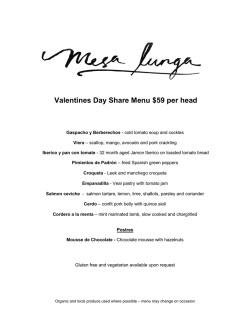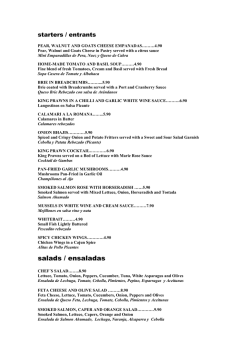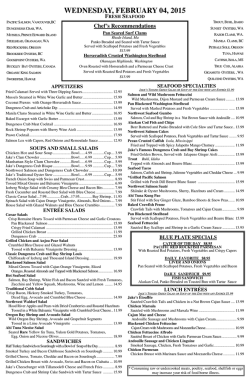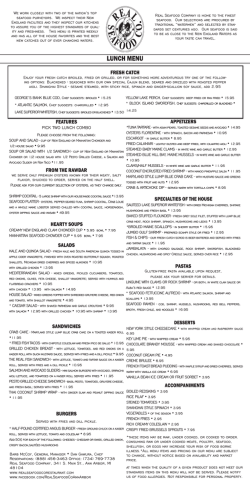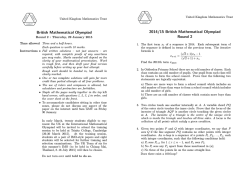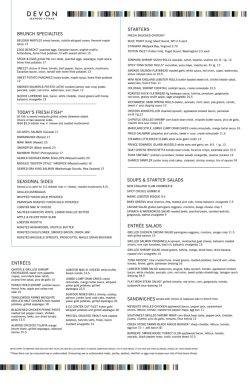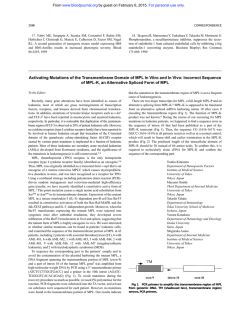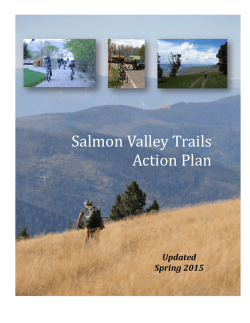
Intermediate Level
Science.gc.ca Activity Book 5 Welcome to the FIFTH edition of the Science.gc.ca Activity Book! Science is all around us and can be discovered, explored and used in so many ways! This new Activity Book showcases the diversity of the world of science through activities in health, biology, environment, agriculture, meteorology, astronomy, engineering, the living world and much more! Science.gc.ca is the official Government of Canada website for Science and Technology (S&T) information and resources. We have put together this Activity Book to stir your inner scientist. Whether you are in elementary, intermediate or secondary school there are activities for all ages and skill levels. These activities can be done individually or with friends in class, at camp, at home or with your Girl Guides of Canada or Scout Canada clubs. If you would like to learn how to make invisible ink, build a mechanically powered launcher or even find out our mystery phrase, you’ll find it all inside this Activity Book! For more activities, you can visit Science.gc.ca and download our previous Activity Books. While you are there, don’t forget to check out Videos, Games and Educational Resources for more science and technology experiments, activities and facts. You can even submit a question to “Ask a Scientist”. Science.gc.ca challenges you to go out, explore and look for science everywhere you go. We would like to thank our funding partners for their ongoing participation and support: • • • • • • • • • • • • • Aboriginal Affairs and Northern Development Canada Agriculture and Agri-Food Canada Canadian Food Inspection Agency Canadian Space Agency Defence Research and Development Canada Environment Canada Fisheries and Oceans Canada Foreign Affairs and International Trade Health Canada National Research Council Natural Resources Canada Natural Sciences and Engineering Research Council Public Health Agency Go ahead, get started; discover and explore the fascinating world of science! Sincerely, The Science.gc.ca Team Science.gc.ca 2 Intermediate Level Activities Best suited for ages 11 to 15 Science.gc.ca 3 Table of Contents Intermediate Level Climate change errors............................................................................................................4 Unscramble the words.............................................................................................................5 Eggsposed to danger...............................................................................................................6 Environment quiz......................................................................................................................7 Construct a mechanically powered launcher.......................................................................8 Identify me...............................................................................................................................11 Conserving energy crossword.............................................................................................12 Build Your own anemometer..................................................................................................13 The salmon spawner...............................................................................................................14 Circle of life.............................................................................................................................15 Weather and climate..............................................................................................................17 Science.gc.ca 4 Natural Resources Canada Climate Change errors Read the following sentences about climate change. Circle the word that is misspelled in each sentence and write it correctly in the space provided. 1. When we produce energy from fossil fuels, we release greenhouse gases (GHGs) into the atmossfere. _____________________________________________________________ 2. All over the world, GHGs are contributing to warming the planet and changing the climeat: rainfalls are heavier, hurricanes are stronger, and we experience more heat waves. _____________________________________________________________ 3. Canada is so big that climate changes are different depanding on where we live. _____________________________________________________________ 4. The northern see ice where polar bears live and hunt is shrinking because of climate change. _____________________________________________________________ 5. When stuff - food, clothes and toys - travvels a long way to get to us, a lot of GHGs are created because of the fuel and emissions from transportation. _____________________________________________________________ 6. When we use our own energy - like riding our bikes to school - we help the enviromnent. _____________________________________________________________ 7. We can use less energy in the summer too - for example, we can close the curtains instead of using the air condichener. _____________________________________________________________ 8. We can all be climate change champeons - by using only the energy we need. _____________________________________________________________ Science.gc.ca 5 Health Canada Unscramble the words 1. CIACEMHLS Clue: All household products are made of these 2. TOCXI Clue: A term used to identify chemicals that are harmful to your health 3. CRORVOSIE 6. EVSPIXOEL Clue: this means the contents of the container will burn skin or eyes Clue: Do not heat or puncture container 4. PSNOIO 7. Clue: This means not to swallow, touch or inhale Clue: Are also known as “Dangerous Goods” 5. FEMLBAMAL 8. HURADAOSZ MIAEATLRS CNUTOIA Clue: Temporary injury may occur Clue: Keep this container away from heat 9. DEAGRN Clue: Temporary or permanent injury may occur 10. ETMXREE DGNERA Clue: Being exposed to even a little may cause injury. Be very careful. Science.gc.ca 6 Fisheries and Oceans Canada Eggsposed to danger Being a salmon egg is risky business. Some of the conditions that kill salmon eggs are: 1. Pollution 2. Movement 3. Silt clouding the water 4. Extreme temperatures 5. A change in the water level Hidden in each of these groups of eggs is a situation that may cause one or more of these conditions. To find out what’s happening to put these salmon eggs at risk, decode the message by crossing out eggs marked J, Q, X, or Z. Then circle the condition (s) (1, 2, 3, 4 and/ or 5) that might be caused by that situation. Decoded message: ______________________ This can cause 1 2 3 4 5 Decoded message: ______________________ This can cause 1 2 3 4 5 Decoded message: ______________________ This can cause 1 2 3 4 5 Decoded message: ______________________ This can cause 1 2 3 4 5 Decoded message: ______________________ This can cause 1 2 3 4 5 Science.gc.ca 7 Environment Canada Environment Quiz 1. Insects help forest ecosystems by: 6. Approximately one quarter of Canada's estimated 140 000 species of plants, animals and micro-organisms are found in the forest. a) Removing old trees b) Recycling nutrients c) Providing new habitat and food for wildlife d) All of the above a) True b) False 1. How many species of trees are found in Canada’s boreal forest? a) b) c) d) 20 100 5 500 3. When lobster mushrooms are infected with a certain parasitic fungus, they become so delicious that they are sought after by restaurants. 7. What Canadian service administers a network of protected areas, which protects an estimated 11.8 million hectares of wildlife habitat? a) Migratory Birds Convention Service b) Environment Canada's Canadian Wildlife Service c) Canadian Service of Ecological Areas 8. All trees in Canada can be distinguished as: a) True b) False 4. Planting a tree is one of the best things you can do for your local environment and for the planet because: a) b) c) d) 9. Canada’s forests are a source of: a) They produce oxygen b) They remove carbon dioxide and contaminants from the air c) They provide habitat for birds and other wildlife d) All of the above 5. To ensure trees are successfully planted: Conifer Deciduous Sycamore A and b a) b) c) d) e) Food Medicine Clean air Water All of the above 10. What is the largest forest in Canada? a) Keep spacing between the trees inconsistent b) Ensure roots are horizontal c) Plant them straight and firmly heeled in Science.gc.ca a) b) c) d) The Hudson Bay Lowlands Great Lakes-St. Lawrence Forest Boreal Forest The Deciduous Forest 8 National Research Council Canada Construct a Mechanically Powered Launcher The very first reported mineral finds on the surface rocks of Mars were discovered in 2004 by the Mars rovers - Spirit (NASA) and Beagle 2 (ESA). Today, 2050, the first Mars colony has been established. As one of the scientists on the colony, you have discovered new minerals and urgently need to send them back to Earth for analysis. The colony has only limited building materials and recycled items. You must build a mechanically powered launcher (MPL) to send a capsule containing mineral samples into orbit, where an Orbiter will retrieve the capsule to bring it back to Earth. The capsule must be launched at a precise angle to escape the gravity of Mars, and reach the proper altitude where the Orbiter awaits. Design Specifications: • • • • • The “capsule” (standard ping pong ball) must be launched by the MPL. Make sure you have a device to hold the “capsule” in place. Only the materials listed are allowed. Decorations are permitted and encouraged, as long as they do not interfere with the function of the MPL. The MPL must fit, completely assembled, into a standard photocopy paper box (432mm x 279mm x 225mm), with the lid on. An oversize MPL will be disqualified. All types of launchers are allowed (catapult, trebuchet, slingshot, etc.) but must only be built with the specified materials. No modifications are allowed to the payload (ping pong ball). Materials allowed: • • • • • • • • • • • • • Paper, cardboard, newspaper Popsicle sticks, tongue depressors, toothpicks, skewers, chopsticks, dowels String, yarn, rope, fabric Glue, play dough, tape Wooden pencils EXCLUDE: Plastics, Styrofoam, rubber Glass, metal (except paper clips), CDs mousetraps, lumber/wood (except Popsicle Spools (wooden, plastic) sticks, tongue depressors, toothpicks, Bottle caps (plastic) skewers, chopsticks, pencils, spools, Paint, decorations dowels), construction kits (Lego, Meccano, Straws, rubber bands K’nex, etc.), batteries, and water. Paper clips Sand and Play-Doh Teams consist of 3 to 5 students with the following responsibilities: • Designer: With input from the other team members, creates the design and obtains authorization from the teacher or volunteer engineer to proceed with construction. Sketches the team’s design drawing. Science.gc.ca 9 • • • Materials Manager: Collects and keeps a record of all materials used by the team during construction. Constructor/Builder: Leads construction of the prototype according to the design drawing plan and includes modifications suggested by team mates. Communication Specialist: Spokesperson for the team who presents project to others. Challenge Construction Tips: • • • • Accuracy and repeat performance are key to the success of the mission. Find a way to launch your capsule so that you obtain the same results launch after launch. Consider the different angles required to hit each target and think of ways to calibrate your MPL so that you can successfully achieve various targets. (Hint: think about how you can use a protractor!) Also consider the ceiling height of your launch area. Make sure the MPL is sturdy enough to survive multiple rounds of testing. If there are delicate parts on your MPL, make some “spares” that can be easily fitted in case of damage during the competition. MPL Testing Criteria: Once construction is completed, teams gather together to test their MPLs against the other teams in the class and/or school. Test your team’s MPL and see if you have successfully conquered the Engineering Challenge! • • • • • • • Teams must attempt to successfully launch their payload and hit targets at 3 different distances – 3m, 4m and 5m. Use standard photocopy paper boxes for targets. Create a launch pad area on the floor, to ensure that all MPLs start the same distance from the target zone. No part of the MPL may cross over the launch line. Mark off a target zone on the floor with masking tape starting with a line at 2.5 m from the front edge of the launch pad. Add more lines at 3.5 m, 4.5m and 5.5m. This creates 3 “target zones” in which to place your target boxes. Target zone width should measure 2 m, with target box placed in the centre. (See illustration below.) Place the first target at 3m, with the centre of the box 3m away from the front edge of the launch pad. Place the second target 4m away and the third target 5m away. Each team will have 2 chances to launch their payload into each target. The payload must land directly in the target (no bounces allowed). Teams will be awarded 1 point for hitting the target zone, 2 points for landing their payload inside the target box and 0 points for landing outside of the target zone. Teams must launch their payload into the 3 successive targets in order, starting with the 3m target. Science.gc.ca 10 Judging Criteria: MPLs will be judged on performance, as well as on the ingenuity of the design and construction. Performance: Performance will be determined by tallying total points accumulated during payload launch attempts. Team Name Target 3m Target 4m Target 5m Total points (max 12 pts) Attempt 1 Attempt 2 Attempt 1 Attempt 2 Attempt 1 Attempt 2 MPL1 1pt 2pts 1pt 2pts 1pt 2pts 9 MPL2 x 2pts 1pt 2pts 1pt 1pt 7 MPL3 2pts x 1pt x x 2pts 5 Evaluation Points Innovation/ workmanship: ingenuity, imagination, attention to detail Presentation by Public Relations person and quality of poster Total Ingenuity Score Science.gc.ca /10 /5 / 15 11 Fisheries and Oceans Canada Identify me Here’s a “salmon speak” code. Each letter has a matching number. Look for a pattern in the number/letter pairs provided, and complete the code. Now, using the salmon-speak code, fill in the blanks. When you’ve finished, the details of my life will reveal which species of salmon I belong to. a 2 n b o c 4 p 15 d 3 q e f g h r s 20 t u Science.gc.ca i 10 v 21 j 9 w 24 k l m x 23 y z 12 Natural Resources Canada Conserving Energy Crossword Across 1. ______ vehicles switch between two types of energy 2. When a car is running but not moving, it is _______________ 3. It is the natural source of all our heat and light 4. Liquid fuel made from plants 5. What is another name for a person walking? 6. _______ the blinds and curtains during hot summer days to help keep the house cool 7. Run this appliance only when it’s full! 8. When you turn your food scraps into fertilizer you are ________ Down 1. 2. 3. 4. 5. 6. 7. 8. Taking big ______ uses more water than taking a quick shower These traditional light bulbs use a lot of energy A “colourful” name for renewable energy If these are properly inflated, vehicles use less fuel A _______ is a cheap way to stay cool Do laundry in _______ water to save energy Use an extra blanket and turn down the ___________ at bedtime When shopping, try to buy things with less ___________ they use less paper and wrappings of all kinds Science.gc.ca 13 Environment Canada Build your own anemometer Purpose An anemometer measures the speed of the wind. You can make one easily with a ping pong ball and the protractor from your math set. Materials • • • • Needle Thread Ping pong ball Protractor Method 1. Cut a piece of thread about 20 centimetres long. Thread the needle and tie a large knot in the end of the thread. 2. Stick the needle into one side of the ping pong ball and out the opposite side. Draw the thread through until the knot at the other end stops the thread from moving. 3. Tie the thread to the centre of the straight base of the protractor so that the ball hangs below the arc of the protractor so that the ball hangs below the arc of the protractor which has the angles marked on it. If the protractor is held level, where there is no wind, then the ball will hold the thread over the 90° mark. 4. Take the protractor outside. Hold it level and parallel to the wind. The wind will blow the ball and when it does, note the position of the thread on the protractor. Record the angle that the ball has been blown and use the chart to convert the angle to a wind speed. Science.gc.ca Anemometer angle to wind speed chart Angle Kilometres per hour 90° 0 85° 9 80° 13 75° 16 70° 19 65° 22 60° 24 55° 26 50° 29 45° 32 40° 34 35° 38 30° 42 25° 46 20° 52 14 Fisheries and Oceans Canada The Salmon Spawner Materials: • • • • • Two 25-metre lengths of rope Four pylons or cones Four to six floor mats, tied into rolls One copy of “Handout: The Salmon Spawner” for each student Writing supplies or art supplies Time required: Approximately 30 minutes in the gym and 30 minutes in class Preparation • • In a gym or open area, place two ropes on the floor, parallel to each other and about four metres apart. Mark the ends of each rope with pylons or cones. Explain that the ropes represent the banks of a straight-sided stream. Have the students find a place in the gym where they can sit without being close enough to touch anyone else. Ask them to find a comfortable position and close their eyes as you read “Handout: The Salmon Spawner” to them. This should help them to relax and focus on the instructions, while minimizing any potential “rough play”. Simulation • • • Have about six students move slowly between the ropes, as if they were spawners swimming upstream. Have another six students link arms and move rapidly (but carefully) side-by-side between the ropes in the opposite direction to the spawners. Explain that they represent a wave of water moving downstream. Have the rest of the class observe how the rapidly moving water pushes the spawners along. Lay some rolled-up mats across the ropes so they are partly in and partly out of the “stream”. Explain that the mats represent logs, boulders and other obstructions in the stream. Have another group of spawners move upstream, while another wave moves downstream. Have the class observe how spawners can hide behind the logs to rest and to avoid the wave. Explain that gravel can accumulate in slow-moving waters and change the shape of the stream bank. Move the ropes so that they curve around the logs and obstructions. Have another group of spawners move upstream, while another wave moves downstream. Have the rest of the class observe how the wave becomes slower as it moves around the curves, and how it can move the stream bank, itself. Science.gc.ca 15 Discussion Have students describe the difficulties in working along the stream under the different conditions. If necessary, prompt them with questions, such as: • In which stream did spawners have the most trouble? In which was it easiest to make it to the end? • What made one part harder than another? • In what ways is the stream similar to the streams a salmon must travel on its trip upstream? How is it different? A salmon also has to jump and slide past a variety of obstacles. It may be easier for a salmon to swim through a wave of water, but its trip is much longer, and the salmon has no hands or feet to help it. • What kinds of obstacles does a salmon have to pass on its migration upstream? Rapids and waterfalls, logs, dams, dried out sections of streams, fishing nets, polluted water, predators, etc. • What natural features help a salmon in its migration upstream? Salmon can find pools behind rocks and logs to rest, and slower water along the edges of a river. Also, their skin becomes very tough, they can jump very high, and use their strong muscles to push their way along. Summation Have students, in groups, review “Handout: The Salmon Spawner” and list at least five changes that salmon face in the last stage of their life. Have students, as individuals, draw or describe in writing Science.gc.ca 16 Handout: The Salmon Spawner In the final stage of their life cycle, salmon re-enter their home river and swim back to the stream or lakeshore from which they emerged as fry. Some travel many hundreds or even thousands of kilometres, swimming from 30 to 50 km a day against the current. They follow the scent of the water to their home stream. Fishers and predators such as bears, otters, racoons and eagles catch many salmon on their trip upstream. When they enter fresh water, salmon usually stop eating and live only on stored body fat. To save energy, they lose the slimy coating that helps protect them, their skin becomes thick and leathery, and they start to absorb their scales. Some internal organs may fail on the journey. The salmon’s appearance changes dramatically, with males and females developing distinct differences. They lose their silvery colour and take on deep red, green, purple, brown and grey colours. Their teeth become long, and they develop a hooked jaw, which is particularly pronounced in males. Their body shape can change, with some species developing a distinct hump on their back. Eggs develop in the ovaries of females, while males develop sperm. When she reaches her home stream or lake, the female uses her fins and tail to find a spot with the right gravel size and water conditions. With her tail, she rearranges the stones in the gravel bed to form a redd, the nest-like depression in the stream- or lakebed where she will lay her eggs. The female deposits her eggs in the redd, then the male deposits his sperm to fertilize them. Some species deposit up to 6,000 eggs, but the average is about 2,500. The female covers the eggs with gravel to protect them, often moving on to build a second or third redd which may be fertilized by other males. Both males and females die within a few days of spawning. (Steelhead and cutthroat may survive to spawn more than once, although once is most common. If they survive, they go back out to sea as kelts, spawned-out salmon, then return to the spawning area in another year or two. Altogether, they may spawn three or four times.) The salmons’ bodies decompose, releasing valuable nutrients, including minerals from the sea. The nutrients from the salmon carcasses form a rich food source for other wildlife, as well as fertilizing the stream and lake along the shore. When salmon carcasses are carried onto the riverbank, they also fertilize the forest and bushes. The ocean compounds in the salmons’ bodies can be very scarce in the upstream environment. If few adult salmon return to spawn, the lack of nutrients can make the forest and the water a poor environment, with few nutrients for growing salmon fry and other species. Science.gc.ca 17 Aboriginal Affairs and Northern Development Canada Circle of life First Nations people recognized a simple, but frequently ignored, fact of life: that everything in nature is connected. This concept is often described as the “circle of life.” In this modern technological age, it can be difficult for many of us to grasp the complexity and interrelatedness of all living things. This activity is designed to illustrate nature’s connections to the students and how the circle of life can be broken by the actions of humans. Plants, animals and the environment within which they live create an ecosystem. Each element and being maintains the ecosystem by transferring energy through a food-chain. Examples of a food-chain include: • • • • herring to salmon to sea lion to orca whale beetle to shrew to snake to fox algae to tadpole to bass to otter bacteria to fungus to tree to squirrel. Purpose: This activity is designed to illustrate how the absence of any component of a food-chain can affect the ecosystem as a whole. Method: • • • • Give students the opportunity to identify a familiar food-chain. If they are unable to do this, use the following example: trees are an important energy source in a food-chain. Aphids feed on the nutrients in the leaves of the trees; the aphids are eaten by sparrows and other birds, which are then eaten by hawks and eagles. Ultimately, the circle is completed when carnivores die, decompose and become part of the earth. Clear a large space in the classroom or, better; go outside to a grassy area. Give each student a number from one to four and put all the “ones” together in one group, etc. Assign each group a component of the food-chain. In the example here, “ones” are trees and “fours” are hawks, etc. Now form the circle of life. One student from each of the four groups should stand in the cleared area. The four students should stand shoulder-to-shoulder, facing the centre of the circle. Keep adding to the circle in sets of four until all the students are in it. Instruct students to turn to their right and take one step toward the centre. Everyone should place their hands on the shoulders of the person in front of them. Tell them that at the count of three, they must slowly sit down, on the knees of the person behind them, keeping their own knees together to support the person in front of them. • When they are all supporting each other, tell them that this represents the circle of life. Tell them that once they have mastered the routine, they will understand how the transfer of energy affects an ecosystem. It may take several attempts before the entire group is able to maintain its composure and posture. Repeat the routine until they have succeeded. • When the group has mastered the routine and a strong lap-sit circle is formed, identify a student who represents an aphid. Tell students that pesticide sprayed on the fields has spread to the surrounding trees. Then remove the “aphid” from the circle. If the circle does not collapse completely, the students will be struggling to maintain it. Students can Science.gc.ca 18 be removed from the circle based on a variety of conditions: logging, toxic waste, urban expansion, soil erosion, acid rain, poachers, oil spills and over-fishing. At a certain point in this activity, the removal of too many students will destroy the effect. Teachers will need to plan this activity with some care and forethought to ensure that students gain as much from it as possible. When the activity is complete, it should be clear to students that a human action that affects any of these crucial components of habitat will have an impact upon the rest of the circle. Ask students what this activity means to them and what they have learned. Science.gc.ca 19 Environment Canada Weather and climate For this exercise, you will need to use a computer with Internet access, or your teacher may choose to collect the information for the class. You may use data for the capital city of your province or territory, or select another location from the city list on the Environment Canada Web site at www.weatheroffice.ec.gc.ca. Set up this exercise at the end of one month so that you can track the temperatures for the entire following calendar month. 1. Use the Past Weather link on the side menu to find the Climate Normals for the city you've chosen. Check to be sure that that location also reports daily highs and lows on their weather forecast Web page. 2. Find the normal daily maximum and minimum temperatures for that city for next month, and draw lines on the graph on the next page to represent these temperatures. Use a different colour for each, but don't use red or blue. For example, if the normal daily maximum is 16.2 C, you could draw a straight line in green at that point running from the first day of the month to the end of the month. 3. The Past Weather section of this Web site gives you Climate Data Online as well. You can use this link once a week for the following month to retrieve the actual daily high and low temperatures for that same city. Plot the daily temperatures using red for the maximum and blue for the minimum. Make a line graph by connecting the dots that represent the temperature values. 4. At the end of the month, compare the lines representing the actual temperatures with the lines representing the normal or average temperatures. a. Did the actual temperatures match the normal ones? b. Which lines would be considered weather and which would be climate? c. In your own words, explain why they are different. Science.gc.ca 20
© Copyright 2025
